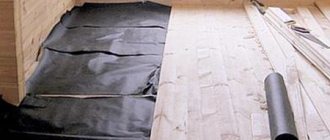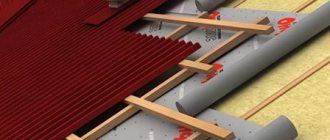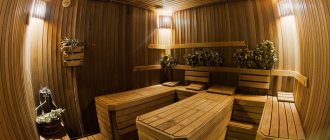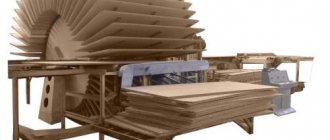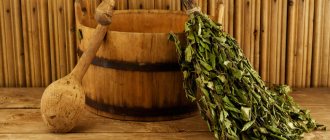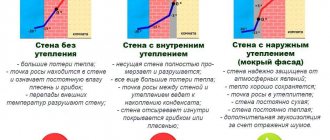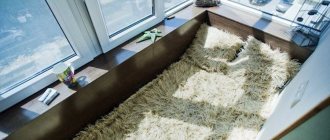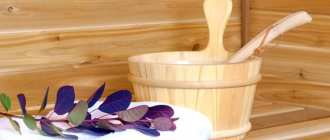About the material
This is a special case of mineral wool - insulation created on the basis of mineral fibers. Fibers can be of three types:
- glass;
- stone;
- slag.
Thermal insulation is provided by the presence of still air between the fibers . Thermal conductivity ranges from 0.030 to 0.052 W/mK (measured dry at 10 °C or 25 °C).
Sound insulation is obtained due to the absorption of sound waves by fibers (the sound absorption coefficient of fibers can be 0.8 - 0.92).
If we compare the thermal resistance of glass wool and brick, then 5 cm of thickness of the first material corresponds to 1 m of thickness of the second.
How is glass wool made?
Considering how glass wool is made and what raw materials are used in production, it becomes clear that this is an environmentally friendly material. The main components are substances used to make ordinary glass - soda, sand, dolomite, etiboron (or borax), limestone. It should be noted that modern glass wool production involves the use of up to 80% cullet.
Further technology is practically no different from the process of manufacturing basalt fibers that form the basis of basalt (mineral) wool, namely:
- Ingredients are poured into the hopper in precise dosages and the melting process begins. Exact compliance with the declared characteristics is ensured by strict control over the composition of the source material. This is what ensures the physical, chemical and operational characteristics of the insulation.
- The molten glass is inflated by steam, which escapes from the centrifuge under pressure.
- Fiber formation is accompanied by additional processing with polymers.
- The thread obtained in this way falls on the rollers and is leveled.
- A fiberglass “carpet” is formed.
- At a temperature of 250 degrees, the polymerization process starts, during which the remaining moisture evaporates, and the fiberglass threads acquire hardness and their yellowish color.
But this is not the whole process of how glass wool is made. After cooling, the insulation goes to cutting and pressing. This allows us to offer the buyer high-quality insulation with high thermal insulation characteristics.
Characteristics and properties
Glass wool fibers are located parallel to each other and are characterized by significant:
- length - from 15 to 50 mm (this is 2 - 4 times longer than stone ones);
- thickness - from 3 to 20 microns,
This gives products made from them strength and elasticity - the greatest among mineral wools.
The specific strength of glass fibers exceeds that of steel wire .
The homogeneity of the composition determines high resistance to vibration, and low density (11 - 45 kg/m3, compared to 30 - 90 kg/m3 for stone wool) - minimal impact on building structures.
High compressibility (90%), softness and elasticity allow high-quality insulation of uneven surfaces and structures of complex geometry.
The inorganic base makes the material unsuitable for eating by rodents and making nests , and is an unsuitable environment for the appearance of fungus and mold.
In addition, glass wool:
- keeps its shape stably;
- does not age;
- does not deform;
- does not cause corrosion of metals in contact with it;
- retains mechanical and thermal insulation properties for decades;
- characterized by frost resistance (used in the range from -60 °C).
The disadvantages include:
- increased fragility of fibers - to protect against the smallest debris, installation should be carried out in special clothing using respiratory protection (for example, respirators); when installing outside, wind protection is required to prevent the migration of fibers (for example, installing fiberglass);
- excessive absorption of moisture (water absorption coefficient for open porosity materials can be up to 20% by weight, up to 2% by volume); moisture that gets inside the glass wool irreversibly changes the structure to a more fragile one, leading to a loss of more than 40% of the thermal insulation properties;
- the appearance of shrinkage over time.
To reduce the effects of moisture, cotton wool is impregnated with special compounds (oils, organic silicon compounds), and water-repellent additives are introduced.
Effect on humans
Working with glass wool
The disadvantage of glass wool is the increased fragility of the fibers, sharp and thin fragments of which easily penetrate clothing (from which they are difficult to remove) and further into the skin, causing itching. Inhaling air containing debris from glass wool fibers can cause long-term irritation to the lungs because they exit the lungs very slowly. It is also dangerous for glass wool fibers to get into your eyes.
To prevent these phenomena, work with glass wool should be carried out in thick protective clothing that does not leave exposed areas of the body, canvas gloves, safety glasses and a respirator.
First aid for vitreous lesions
If glass wool gets on your skin, you should never itch it, as this will only drive the debris into the skin. Try to gently shake the glass wool out of your hair by placing your head in a bathtub (without water), closing your eyes and shaking your head. Take a cold shower with strong water pressure without detergents. Do not rub the skin with washcloths, sponges, or use hot water, as it dilates the pores of the skin. After taking a shower, do not dry yourself with a towel.
Wait until your body is dry and take a cold shower again, this time with soap. If glass wool gets into your eyes, rinse them with a strong stream of cold water. If irritation does not go away, immediately contact an ophthalmologist, preferably an eye surgery clinic, or call an ambulance. If you inhale broken glass wool fibers, if you have persistent coughing, difficulty breathing, etc., consult a doctor immediately. It is better to throw away clothes contaminated with glass wool. Even careful repeated washing does not completely guarantee the removal of fibers.
Compound
What is glass wool made of? This material contains both the main components that provide its properties as insulation, and binders that allow it to maintain strength and integrity.
Basic:
- glass or broken glass;
- natural quartz sand;
- limestone (chalk);
- soda ash;
- boric acid;
- borax (sulfate);
- dolomite;
- fluorite
Binders:
- polymer resin;
- clay;
- spar;
- other substances.
Binder components can make up 2.5 - 10% by weight.
The question that some people have, why there is glass in glass wool, can be answered as follows. The presence of this component determines the important properties of the material, namely:
- non-flammability;
- unattractive to rodents and mold;
- strength and durability.
If instead of glass wool there were, say, wood fibers in glass wool, all these advantages would be reduced to zero.
A little about the terms
Strictly speaking, it is not entirely correct to consider these materials different. Technically, mineral wool is a whole group of heat insulators, the fibers of which are obtained from the melt of fossil raw materials and minerals. Depending on the composition, they distinguish between stone or basalt wool, slag wool from ore production waste, and glass wool from components that are used in the manufacture of glass - quartz sand, soda, limestone, or even from glass waste itself. But over time, slag wool began to lose ground, and the name “mineral wool”, at the suggestion of marketers, became popularly assigned to basalt insulation.
Does glass wool burn?
Glass wool does not support combustion and belongs to the class of non-combustible materials (NG).
Such materials can withstand high temperatures while maintaining structural integrity, strength and other properties; they do not ignite .
The material is sintered at temperatures from 500 to 550 °C.
The temperature range of use is determined by the composition, more precisely, by the organic resins included in the composition as a binder. For glass wool, the upper limit is from 250 to 450 °C. Exceeding this range can be considered the melting point.
In this case, the upper limit is determined by the burnout temperature of the resins, as a result of which the material loses its binder, and, consequently, its performance properties.
When exposed to fire, no toxic or harmful substances are released .
Production and technical characteristics of glass wool
The same components are used for production as in glass production: limestone, borax, sifted sand, dolomite, soda. Most manufacturers replace raw materials with glass cullet (up to 80%), which reduces the final cost and does not affect the quality of the product.
The production technology consists of several stages:
- The components (broken glass products, fillers) are immersed in a hopper and fused at a temperature of 1400°C.
- The molten mass is inflated under the influence of steam.
- Polymers are added to form threads.
- The fibers are directed to leveling rolls, which form a kind of “carpet” of fiberglass.
- Polymerization at 250°C. The remaining moisture evaporates, the material cools down and becomes yellowish.
- After cooling under natural conditions, the fiberglass is sent for pressing and cutting to size.
Production stages
*
The material is produced in slabs, mats, rolls. Each manufacturer determines the dimensions of the slabs independently. The main parameters of insulation produced in rolls are presented in the table.
Roll sizes
The properties and characteristics are as follows:
- Thermal conductivity. Due to the fibrous structure, air is retained in the volume of the material, which ensures low thermal conductivity (0.039-0.047 W/m K.
- Sound absorption (35 to 40 dB). The fibers of the material do not contribute to the spread of vibrations and noise.
- Vapor permeability (0.6 mg/mh·Pa). According to this parameter, insulation has an advantage over other materials.
- Fire resistance. Before purchasing, many people doubt whether modern glass wool will burn? It can withstand temperatures up to 500°C, and under the influence of fire it begins to sinter smokelessly without the formation of hazardous substances.
- Moisture resistance. When partially immersed in liquid, the moisture absorption parameter is 15%.
- Biological inertia. Does not contribute to the development of fungal colonies, the appearance of rot, and is not interesting for rodents.
- Deformation stability. The insulation can be compressed 6 times without losing its properties, and after removing the load it straightens to its original volume.
- Density. Depending on the manufacturer, the parameter ranges from 11 to 25 kg/m3.
Glass wool has good characteristics
Areas of application
If we talk about industries of application, then these are:
- construction;
- heat supply;
- production;
- automotive industry;
- aviation;
- pipeline transportation of materials.
For each sphere, different types are selected , differing:
- fiber type,
- their location,
- the presence of additional coatings,
- density (maximum possible - 130 kg/m3).
The most common types of glass wool are rolls and soft mats.
Fiberglass insulation is available in the form of:
- continuous thread (rolls);
- staple (cut) fiber (slabs), including those characterized by increased rigidity with lining;
- soft mats;
- reinforced rolls;
- cached technical insulation, including in the form of foil products.
Rolls have long been successfully used for insulating horizontal surfaces - floors, roofs.
Cached type - for insulating high-temperature pipelines, components and containers.
Mats and slabs are used for thermal insulation of various rooms and structural elements, namely:
- facades;
- window and door openings;
- interfloor and other floors;
- internal and external partitions of buildings;
- sound and thermal insulation of cabins.
The cotton wool should be secured in such a way as to ensure a free position (for maximum expansion) and at the same time a tight fit without gaps.
Areas of use
Before purchasing the material described, you should familiarize yourself with the areas of its use. Among others, it is worth highlighting:
- external works;
- roofing;
- thermal insulation of horizontal surfaces;
- sound insulation and insulation of partitions and walls.
For each of the spheres, different types of glass wool are selected, which differ in the type of fibers. Each material has or lacks additional coating, for each variety. The fibers in them are arranged in their own way, which affects thermal conductivity.
Different types also have a certain density. Therefore, the choice of glass wool must be approached seriously, because this is the only way to achieve high quality work and durability of the product.
Production
Production begins with the introduction of the starting components into the melting furnace. As a result of exposure to a temperature of 1400 °C, the centrifugal forces of centrifuges and steam inflation, glass threads are obtained .
To obtain the finest threads with the required mechanical properties, strict adherence to the recipe composition is required.
The threads treated with polymer binding solutions (modified urea, phenol-algid polymers) are sent to conveyor alignment to form a homogeneous fiberglass web .
Next comes the polymerization stage - a temperature of 250 °C becomes a catalyst for the formation of polymer bonds and the removal of excess moisture.
Cooling, cutting with saws and cutters, then pressing (compressed 5-6 times), packaging in polyethylene - we get rolls and slabs ready for transportation .
The use of cullet as the main component deserves special attention.
Modern technologies make it possible to add up to 80% glass powder obtained by crushing and grinding commercial glass waste.
The composition of cullet is regulated by national standards - GOST R 52233-2004. According to the provisions of the document, this secondary raw material can be of 1 or 2 grades and one of five brands in accordance with color (BS, PST, PSL, ZS, KS).
Glass wool obtained as a result of disposal and processing of household and industrial glass waste meets all the requirements for these products.
At the same time, a product made from recycled materials has a lower production cost compared to traditional technology, and, as a result, a more affordable price for the consumer.
Many companies are involved in the production of glass wool using this technology, including:
- Isover;
- URSA;
- Knauf.
The song “New Year” and enormous popularity
The creator of the group “Steklovata”, Sergei Kuznetsov, was the founder of the legendary boy band “Tender May” and the author of the song “White Roses” and other hits. After a conflict with the group’s producer Andrei Razin, he left “Tender May” and began to assemble similar groups of young guys. One of them was “Glass Wool,” created in 1999.
Initially, only Denis Belikin and Arthur Eremeev sang in “Steklovat”, later Alexander Gulyaev and Sergey Dyadyun joined them. In 2001, the guys recorded a video for the song “New Year”, it was shown on Orenburg television.
Lyrics of the song Glass wool “New Year”:
At the hour when candles are lit in every house and every window, it's a festive evening. Even if there is a blizzard and wind outside, But even they smile at me, And the clock rings on a festive evening
Chorus: New, new, new year will fulfill all your dreams! New, new, new year we will remember for a year! New, new, new – don’t spare the candles for the year! New, new, new year on New Year's Eve! New Year! New Year! New Year!
The Christmas tree was decorated with gold, That night the city became a fairy tale, A sea of lights in festive colors. The smell of soft green needles has been our dream for many months. Let the blizzard give me its wind!
New Year's winter fairy tale, And twelve strokes of the clock, The white blizzard will become kinder. Carnival bright masks, The noise of cheerful, intoxicated voices. Wish each other happiness at twelve o'clock!
This masterpiece remained in oblivion until it was posted online in 2008. The song was noticed on MTV's Shit Parade program. Since then, the triumphant march of the song and the group “Steklovata” began.
The video was shown on his blog +100500 by Max Golopolosov, which brought him even wider popularity. The actors of the show “Big Difference” also portrayed “Glass Wool” in a parody of the video blog +100500.
The original video and its copies began to receive millions of views, and parodies of “New Year” began to be made all over the world. In 2012, the already matured guys from “Glass Wool” were invited to the show “Let Them Talk” on Channel One.
Manufacturing standard
The production of glass wool is regulated by a number of regulatory documents . GOST 19170 2001 is considered the main one.
It describes:
- production methods;
- safety measures when working with the material;
- scope of application.
Manufacturing is allowed in accordance with our own technical specifications approved in the appropriate manner .
Pros and cons as insulation
Based on the properties of glass wool, both positive and negative qualities .
The advantages include:
- good heat and sound insulation properties;
- fire safety;
- resistance to biological influences (pests, bacteria);
- light weight;
- ease of transportation;
- low cost (700 – 2100 rubles).
On the downside:
- hygroscopicity (need for additional vapor barrier);
- inconvenient installation (need to use protective equipment);
- the appearance of shrinkage after 8–10 years of service.
What is glass wool made from?
What is glass wool made from? This material contains both the main components that provide its properties as insulation, and binders that allow it to maintain strength and integrity.
Basic:
- glass or broken glass;
- natural quartz sand;
- limestone (chalk);
- soda ash;
- boric acid;
- borax (sulfate);
- dolomite;
- fluorite
Binders:
- polymer resin;
- clay;
- spar;
- other substances.
Binder components can make up 2.5 - 10% by weight.
The question that some people have, why there is glass in glass wool, can be answered as follows. The presence of this component determines the important properties of the material, namely:
- non-flammability;
- unattractive to rodents and mold;
- strength and durability.
If instead of glass wool there were, say, wood fibers in glass wool, all these advantages would be reduced to zero.
Is there any harm to human health?
information chaos in this issue .
Manufacturers selling glass wool talk about its harmlessness, while competitors offering other insulating materials talk about its adverse effects.
We will not argue, we will only report the facts.
Glass wool can be dangerous and pose a threat only during its installation - there is a possibility of glass dust coming into contact with the skin and respiratory system .
For protection it is necessary to use special clothing and respirators.
There is good news on this issue - modern technologies make it possible to produce materials that do not spread glass dust.
Upon completion of installation, glass wool insulation becomes absolutely harmless .
Workwear is cleaned:
- shake off;
- vacuuming;
- wash with 3-4 rinses;
- repeated treatment with a vacuum cleaner after drying.
If glass wool particles come into contact with your skin, take a cool shower with strong pressure without using detergents.
Why cool? Because hot water promotes the expansion of pores, and, consequently, the penetration of glass particles.
Rules for working with glass wool
- Before working with glass wool, it is necessary to straighten it and clean it of all crumbling parts. The insulated structure itself is treated with antiseptic compounds;
- In case of insulation of the ceiling, you can use lathing or do without it. In the latter case, a lubricating polymer waterproofing is applied to the ceiling. In addition to its main properties, this component improves adhesion with the adhesive composition, which we will apply to the ceiling and cotton wool after drying. As soon as the glue is applied to the surface, it is necessary to press the insulation against the ceiling and hold for several minutes;
- If the material is highly flowable, you cannot work with it without a respirator. Otherwise, glass fibers entering the lungs may cause health problems. These problems can be very different, ranging from shortness of breath and allergies to respiratory diseases, even cancer. If you don’t have a respirator at hand, create a high-quality gauze bandage;
- When working, it is necessary to avoid rubbing cotton fiber particles into the skin. If these fragments come into contact with the skin, rinse with water. After work, it is recommended to take a shower;
- Washing clothes after use is not recommended as this will not remove dust. The ideal solution is shaking.
Disposal
Glass wool can be obtained by recycling cullet. How is it disposed of?
Today there are three options :
- Burial in special landfills.
- Grinding in pure form and reuse in road construction, brick production.
- Used in the form of a charge - a solid residue formed during the combustion of waste. In this case, the glass component can reach 78% of the total volume, almost 20% is clay, 2% is sodium silicate.
The price of recycling services for recycling glass wool ranges from 400 to 1,000 rubles per ton .
There are also installations (mills) for processing (deep grinding to sizes of 0.1 - 100 microns) industrial waste glass fiber and its return to the technological process.
Glass wool production equipment | Business Industry
Glass wool is a heat-insulating material that is widely used in construction, the automotive industry (heat and sound insulation of car cabins), insulation of heating network pipes and many other industries. Glass wool has such positive properties as high strength and elasticity.
Since there are almost no foreign inclusions in glass wool, it has increased vibration resistance. Main components for glass wool production:
- limestone,
- quartz sand,
- soda ash,
- borax (sulfate).
Equipment for the production of glass wool is a complex technological complex consisting of many components and devices.
Equipment for the production of glass wool consists of the following main parts:
- loading bins;
- material mixing and dosing system;
- melting furnace;
- centrifuge;
- fiberization unit;
- shaft system for rolling glass wool;
- polymerization and drying chamber;
- cutting unit;
- pressing unit;
- packaging machine.
Technological comb of equipment for glass wool production
The main components are loaded into bunkers, according to the recipe, using dosing devices in the mixing system, all parts are thoroughly mixed. The finished mixture enters the melting furnace, where at a temperature of 1400 - 1450 °C it is heated to an almost liquid state.
Next, the molten mass enters a centrifuge, from where, using steam, thin threads are obtained by blowing. Hot fiberglass strands enter the fiberization unit, where they are treated with polymer aerosols (a solution of phenolic polymer modified with urea).
The processed threads enter the rolling unit - a system of shafts, where the fibers are aligned over the entire area of the fabric. The canvas is sent to a polymerization chamber, where at a temperature of 250°C polymer bonds are formed, and drying occurs and excess moisture that remains after using the aerosol is removed. Upon exiting the chamber, glass wool becomes hard and acquires an amber-yellow hue.
Next, the glass wool is cooled to a temperature of 20–30 °C and supplied to the cutting unit. Using cross saws and longitudinal cutters, the wool sheet is divided into rolls or mats.
The resulting glass wool is saturated with air and has a large volume, so it then goes to the pressing unit, where sixfold compression occurs. The compressed material is packaged in polymer film, marked and transferred to the finished product warehouse.


